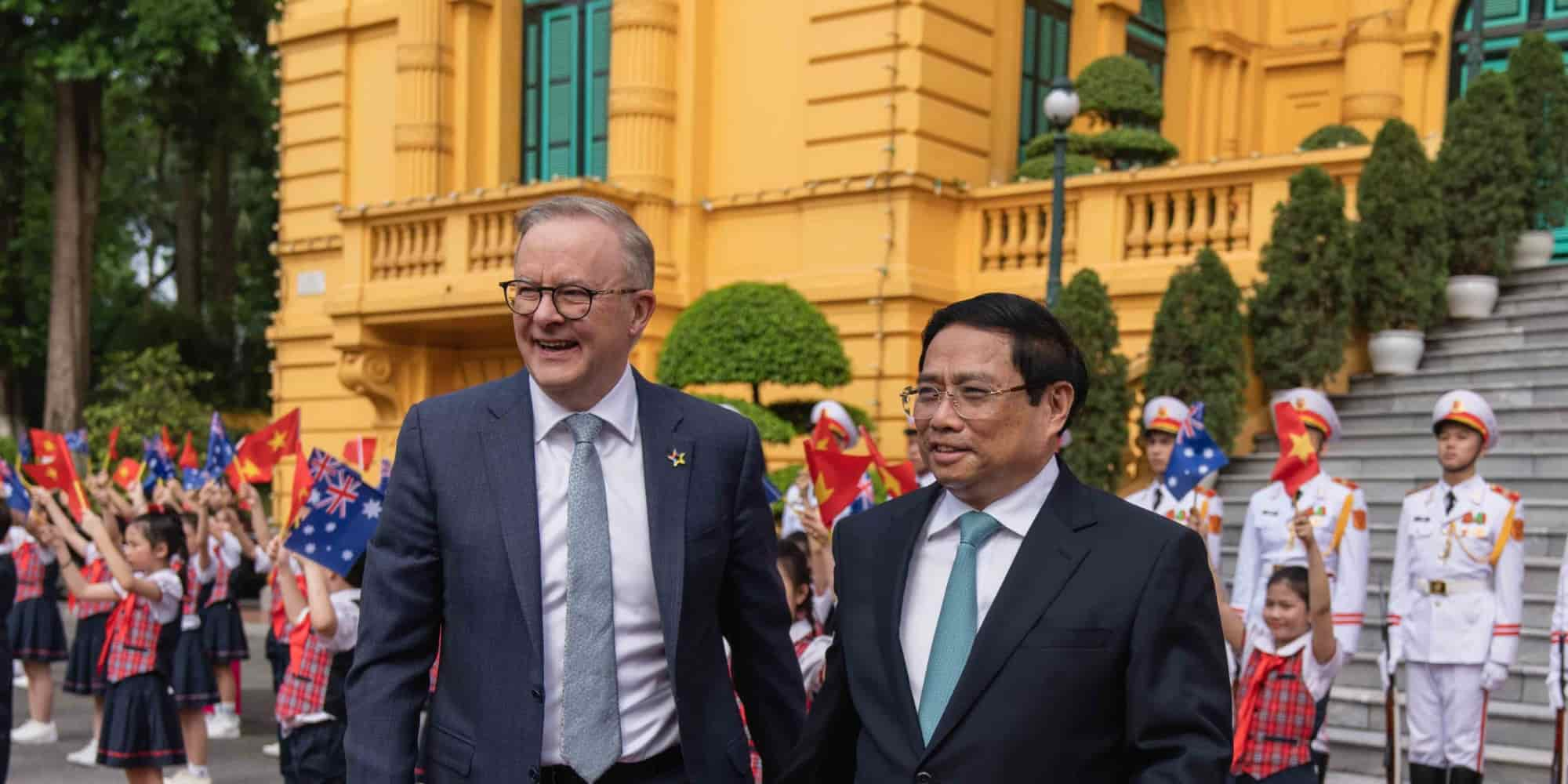The 50-year transformation of Australia-Vietnam relations
When Prime Minister Anthony Albanese visited Vietnam last weekend, he took an important symbolic step in a long history of consolidating bilateral relations. Carlyle A. Thayer reviews a remarkable transformation that in five decades turned Vietnam from enemy to valued friend and partner.
9 June 2023

In February 1973, the Whitlam Labor Government extended diplomatic recognition to the communist Democratic Republic of Vietnam (DRV, North Vietnam), a recent adversary in the Vietnam War. Fifty years later, Australia and the unified Socialist Republic of Vietnam (SRV) are poised to become comprehensive strategic partners, a status Vietnam has only accorded to four countries – Russia, India, China, and South Korea. Prime Minister Anthony Albanese recently declared that Vietnam will become one of Australia’s top-tier partners.
What accounts for this remarkable transformation? Over the past 50 years four main factors have shaped the evolution of bilateral relations: economic ties, political-diplomatic regional engagement, growing convergence in geo-strategic outlook, and people-to-people linkages. As bilateral relations developed multiple areas of cooperation were expanded and deepened.
This article presents an overview of how the bilateral relationship evolved over three distinct stages.
The Third Indo-China War (1973-1991)
During the first stage, from 1973 to 1991, Australia was one of the first western countries to extend diplomatic relations to the DRV after the signing of the Paris Peace Agreement in January 1973. Peace was short-lived. Vietnam was reunified militarily in 1975 and soon after the Third Indo-China War erupted pitting the Khmer Rouge in Cambodia and their Chinese backers against newly reunified Vietnam.
After reunification in 1976, Vietnam took its first tentative steps to open economically with non-socialist countries by encouraging foreign investment. Australia’s options for engaging Vietnam economically were limited because of a continuing US embargo. However, in 1977 Australia supported Vietnam’s membership of the United Nations.
Following Vietnam’s intervention in Cambodia in late 1978, the then five-member ASEAN led international efforts to impose an aid and trade boycott on Vietnam. Malcolm Fraser’s Coalition Government suspended its aid program and economic relations with Vietnam were put on hold. At the same time, Australia began welcoming refugees and asylum seekers from Vietnam.
During the Cambodian conflict Vietnam and Australia witnessed the first stirrings of converging strategic interests. The Fraser Government’s foreign minister Andrew Peacock took the position that ostracizing and isolating Vietnam was counterproductive because it would only drive Vietnam further into the arms of the Soviet Union. This theme gained currency under the Labor Governments of Bob Hawke and Paul Keating and in the proactive efforts of foreign minister Gareth Evans to broker a peace settlement.
Vietnam too began to look beyond the conflict in Cambodia. In late 1986, Vietnam adopted a major program of economic reform and opening known as doi moi or renovation. In May 1988, The Politburo of the Vietnam Communist Party (VCP) adopted Resolution No. 13, a seminal strategic policy document, that elevated economic development and expanding international relations as top priorities.
In October 1991, an international settlement was reached ending the conflict in Cambodia and Vietnam’s pariah status. The following month Vietnam and China normalised relations. Australia restored its development assistance. Vietnam was now well on the path to achieve the objectives of Resolution No. 13.
Normalization of Relations (1992-2008)
The second stage of Australia-Vietnam relations was marked by the deepening of economic relations, the initiation of defence-security cooperation, common membership in regional multilateral institutions, and increased people-to-people contact through education and training initiatives.
In the 1990s Vietnam transitioned to a 'socialist market economy.' This process was marked by two milestones, Vietnam’s membership in APEC in 1998 and the World Trade Organization in 2007. These developments gave reassurance to foreign investors and trade partners that Vietnam would adhere to the international trading regime.
Australia took advantage of Vietnam’s economic opening. In 1994, Paul Keating became the first Australian prime minister to visit Vietnam. Australia moved up the ladder of Vietnam’s trade and investment partners. Australian service providers Phillip Fox and ANZ Bank began operating in-country.
The year 1995 was a pivotal one. In July, Vietnam normalized relations with the United States. The Clinton Administration gradually lifted the war-era trade embargo on Vietnam, thus facilitating Vietnam’s integration into the global economy.
Also in July, Vietnam became ASEAN’s seventh member and a committed adherent of Southeast Asian regionalism. Australia-Vietnam relations now embraced ASEAN’s multilateral network of institutions such as the ASEAN Regional Forum (ARF) and East Asia Summit (EAS). These developments proved a decisive catalyst in the growing convergence of geo-strategic outlook between Canberra and Hanoi.
In July-August 1995, Australia hosted a visit by Do Muoi, the General Secretary of the VCP, thus tacitly acknowledging Vietnam’s one-party political system and the paramount role of the VCP’s leader. Australia and Vietnam went on to formally establish defence relations in 1998, and exchanged defence attaches in 1999 and 2000, respectively.
People-to-people ties also deepened when the Royal Melbourne Institute of Technology (RMIT) was given permission to open the first of three campuses in Vietnam. Over the years this proved a solid foundation for an expanding network of Vietnamese alumni.
Institutionalization
The third stage in the evolution of Australia-Vietnam relations was marked by institutionalization. This took the form of three milestone agreements: comprehensive partnership in 2009, enhanced comprehensive partnership in 2015, and strategic partnership in 2019.
The agreement on comprehensive partnership outlined six areas of cooperation: political ties and public policy exchanges; economic growth and trade development; development assistance and technical cooperation; defence and security ties; people-to-people links; and advancing the global and regional agenda via the United Nations Security Council, APEC, the ARF and EAS. The goals of cooperation in each of these areas was set out in a three-year Plan of Action (2010-13). Notable developments included the signing of a Memorandum of Understanding on Defence Cooperation in 2010 and funding for the Cao Lanh Bridge across the Mekong River, the largest single Australian aid program in mainland Southeast Asia (2013-18).
In 2015, Australia and Vietnam issued a declaration on enhancing the comprehensive partnership. This declaration outlined eleven specific areas of endeavour, extending the list of cooperative activities to include human rights, the Vietnamese community in Australia, scientific collaboration, agriculture, and environment and climate change. Significantly, the declaration highlighted convergent views of 'ensuring security, safety, and freedom of navigation and aviation… [and] a code of conduct in the South China Sea'
The third milestone in this period was agreement in 2018 to raise bilateral relations to a formal strategic partnership by institutionalizing annual ministerial meetings and dialogues. Australia and Vietnam identified seven regional and international issues where they held convergent views: open, inclusive and rules-based regional order; ASEAN; ASEAN centrality in the ARF, EAS and ASEAN Defence Ministers’ Meeting Plus; non-traditional security issues; environment and climate change; South China Sea; and APEC, Trans-Pacific Partnership and Regional Comprehensive Economic Partnership
Notable outcomes included the Joint Vision Statement on Further Defence Cooperation issued in 2018, Australian provision of COVID-19 vaccines and related medical supplies, and the Enhanced Economic Engagement Strategy adopted in 2021 to double two-way investment and become each other’s top ten trade partners.
Towards a Comprehensive Strategic Partnership
The initiative to raise bilateral relations to a comprehensive strategic partnership was taken by Prime Minister Scott Morrison in 2021 when he broached the idea to Vietnam’s leadership. Morrison’s initiative lay dormant until after the election of the Labor Government in May 2022.
The Albanese Government’s prioritization of relations with Southeast Asia, the centrality of ASEAN, and special role of Vietnam were instrumental in convincing Vietnam’s leaders that the time was ripe to raise bilateral relations to the next level. Prime Minister Albanese’s visit to Vietnam last weekend marks an important milestone in reaching an agreement on a comprehensive strategic partnership by the end of the year. This development will take us full circle in underscoring Australia’s historical recognition of the potential Vietnam holds as a partner to address a wide-ranging agenda of common bilateral, regional and international issues.
In 2021, Vietnam set the goal 'to become a modern industrial country with upper-middle income by 2030, and a developed, high-income country by 2050.' An agreement on a comprehensive strategic partnership will be mutually reinforcing in the future development of both Australia and Vietnam as they address common challenges posed by major power rivalry, climate change mitigation, green energy transition, emerging technologies and innovation.
Carlyle A. Thayer is Emeritus Professor, The University of New South Wales at the Australian Defence Force Academy, Canberra.
How can we help? Get in touch to discuss how we can help you engage with Asia
